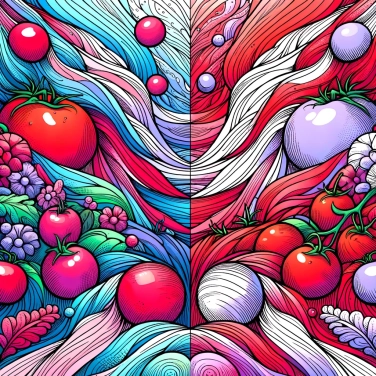Tomatoes are red due to the presence of pigments called lycopene. These molecules absorb blue and green light, reflecting red light, giving the tomato its characteristic color.

The secret of the bright red color of tomatoes is called lycopene. It is a natural pigment that belongs to the large family of carotenoids, these molecules known for coloring fruits and vegetables in various shades ranging from yellow to intense red. Lycopene absorbs certain light rays and reflects red, which gives tomatoes their well-known color. Initially, the tomato is green because it mainly contains chlorophyll. As it ripens, chlorophyll disappears and lycopene gradually concentrates, changing the tomato from green to bright red. The more a tomato ripens, the more abundant the lycopene, hence its final vibrant color.
A green tomato mainly contains chlorophyll, the pigment that gives plants their green color. But as the tomato ripens, chlorophyll degrades, making way for lycopene, the bright red pigment characteristic of ripe fruit. Temperature, sunlight, and humidity also influence the formation of lycopene. Excessively high temperatures (over 30°C) can even slow down its production, resulting in paler or orange-yellow tomatoes. Conversely, good sun exposure promotes the synthesis of lycopene, intensifying the red color of tomatoes. Fruits ripening under natural light generally develop a richer and more uniform pigmentation than those ripened artificially.
The red color of tomatoes is primarily due to a few key genes. Among them, a gene called r (ripening inhibitor) acts as the conductor by regulating the formation of red pigments, especially lycopene. Some varieties of tomatoes naturally produce more lycopene, giving them a brighter red color. Conversely, genetic mutations sometimes lead to a reduction in lycopene, resulting in rather orange or even yellow tomatoes. This genetic diversity delights gardeners and adds color to salads!
The bright red color of tomatoes mainly comes from lycopene, a natural pigment belonging to the carotenoid family. This compound is a powerful antioxidant, meaning it plays a beneficial role in protecting the body's cells from damage caused particularly by oxidative stress. Regularly eating well-red tomatoes, which are rich in lycopene, helps prevent certain health issues such as some types of cancer and cardiovascular diseases. Moreover, the redder and riper a tomato is, the more lycopene it contains, making it better for your body. The interesting thing is that the lycopene found in cooked tomatoes (like tomato sauce or homemade ketchup) is even better absorbed by the body than that from raw tomatoes. So, in terms of nutrition, a nice intense red color often indicates a tomato that is good for you.
Lycopene, the compound that gives tomatoes their characteristic red color, is more readily absorbed by the body when tomatoes are consumed cooked rather than raw.
Not all tomatoes are red! There are yellow, orange, pink, green, purple, and even black varieties, each with a slightly different flavor and a unique nutritional profile.
Storing fresh tomatoes in the refrigerator can diminish their taste and flavor, as the cold affects the production of aromatic compounds. It's better to keep them at room temperature.
It is the rays of the sun during the ripening of the fruit that stimulate the synthesis of certain pigments like lycopene in tomatoes. A lack of light will result in less colorful and less flavorful tomatoes.
Red tomatoes are high in lycopene, a powerful antioxidant linked to the prevention of certain chronic diseases. However, each variety of tomato offers a unique combination of antioxidants, vitamins, and minerals. Therefore, it is beneficial to incorporate different colors into your diet to diversify your nutritional intake.
When tomatoes are heated, their red color may initially intensify because cooking increases their content of bioavailable lycopene. However, prolonged cooking or exposure to heat can diminish this vibrant color and cause it to shift slightly towards orange. Despite these changes in appearance, the nutritional benefits of lycopene generally remain intact.
Although unripe green tomatoes contain alkaloids such as tomatine, they are generally safe to consume in small amounts, especially when cooked (for example, in jams, chutneys, or fried fritters). However, it is advisable to avoid consuming them in large quantities, as excess alkaloids can cause digestive issues.
Indirectly, yes. The color red is often associated with the ripeness of the tomato. A ripe tomato with a bright red color generally contains more sugars and less acid, giving it a sweeter and more balanced flavor compared to green or partially ripe tomatoes, which are often more acidic and less sweet.
No, although red is the most common color, there are varieties of tomatoes in various colors such as yellow, orange, green, black, and even purple. This diversity is due to the different concentrations and types of pigments present in their skin and flesh, such as carotenoids, anthocyanins, and chlorophylls.

No one has answered this quiz yet, be the first!' :-)
Question 1/5